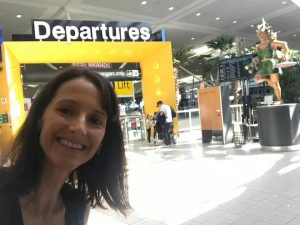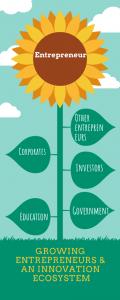
It takes an ecosystem to raise an Entrepreneur | Part 1
 Some of you may have seen my selfie at the international departure lounge two weeks ago, ready to embark on an experience of a lifetime. I was on a Startup Catalyst Mission, which has given me a fresh perspective on entrepreneurship and entrepreneurial thinking. After a successful application for a $6000 Advance Queensland Grant to fund my place on the mission to the United States of America (USA), our duty was to ‘come back and be a contagion’, to infect as many around us as possible with the ideas and learnings from the ten days of madness.
Some of you may have seen my selfie at the international departure lounge two weeks ago, ready to embark on an experience of a lifetime. I was on a Startup Catalyst Mission, which has given me a fresh perspective on entrepreneurship and entrepreneurial thinking. After a successful application for a $6000 Advance Queensland Grant to fund my place on the mission to the United States of America (USA), our duty was to ‘come back and be a contagion’, to infect as many around us as possible with the ideas and learnings from the ten days of madness.
The Queensland and Australian Governments understand that by imagining new ways of doing things, tackling today’s challenges, grasping tomorrow’s opportunities, and preparing our future generations, we will prosper, continuing to move forward as a country, a state, a community, and as individuals (https://advance.qld.gov.au/).
This is part 1 of sharing insights and adventures from the Startup Leaders Mission to the USA, 9-19 March 2019. I hope through these reflections, I get you excited about your student’s entrepreneurial thinking futures and creativity endeavours! Hopefully, you too will gain a fresh perspective on our school mission to prepare resilient global citizens who are innovative thinkers with a heart for servant leadership.
Why entrepreneurial thinking?
Entrepreneurs can act in situations when things are not known. They are experts at mastering uncertainty. It is the entrepreneurial force that takes hold first when uncertainty exists. They have the MINDSET, the ability and drive to ACT, and most importantly, add VALUE. “The pace of change has never been this fast, yet it will never be this slow again!” (Trudeau, World Economic Forum, 2018). Who copes and thrives in this type of environment? Those with entrepreneurial thinking.
Raising an entrepreneur
The mission lens was to look, listen, and observe everything, not just the entrepreneurs. We explored Colorado and California, spoke to a myriad of people, and visited over 15 organisations. Through frameworks such as Startup Communities (The Boulder Thesis), and Rainforest (Silicon Valley), I very quickly realised it takes an ecosystem to raise an entrepreneur. If one part of the system fails to perform its part, it falls over. If you remove one of the elements, creativity, entrepreneurship, and innovation just don’t flourish.
Here’s the ecosystem elements that allow our entrepreneurs to truly bloom; Education, Government, Corporates, Investors, and other entrepreneurs. I will briefly discuss education and in the following editions, I will expand on each component.

- Education:
Nurturing and allowing creativity and entrepreneurial thinking as early as possible is key. My observations of the USA locations we visited, their universities are restructuring and driving entrepreneurial thinking across all faculties, integrating into subjects, and encouraging cross faculty pollination of ideas. They have some innovative thinking on how they are doing this…for a later edition!
BUT, why not focus earlier?
When I asked questions of our American colleagues about the role of schools in their innovation ecosystems, I was often faced with blank looks or a vision, but not yet a lot of action. That is not to say it isn’t happening, but if it is, the other areas of the ecosystem don’t know. A key takeaway is that St Paul’s is ahead in relation to creative and entrepreneurial thinking in the school setting and promoting it through our communities. We prepare all students with these thinking skills, not just those who enter the university system. Through the St Paul’s Realms of Thinking, Centre for Innovators and Entrepreneurs (CIE), and in our everyday teaching practices, creative dispositions (that underpin entrepreneurial thinking) are a focus and deliberately ingrained in everything we do!
Through the CIE, we introduce students to frameworks that are usually reserved for universities or other tertiary courses and ‘adulthood’. A key learning from University of Colorado, is that the purpose of framework education is repeatability and reflection; exposing students to the entrepreneurial framework and process over and over again, term after term, year after year. Within the university setting, they are promoting opportunities for students to use the framework, at least 4-5 times a year so it becomes like a muscle memory. That way, when they want to ‘flex’ their entrepreneurial muscles potentially later in life, their muscle memory is there (Kyle Judah, Director of Director of Entrepreneurship, College of Engineering & Applied Science, CU). Every time a student uses the framework, they come with new curiosity, new learnings, new knowledge, a new team, a more mature approach, and greater chance of success.
This year the CIE’s vision includes opening up the Entrepreneurs Club to more students, more often through a shorter, more intense approach within the school timetable. My learnings from the American ecosystems fully support this approach and now more than ever, I now see it as more important that we provide and encourage access to learn and practice these entrepreneurial frameworks, over and over again.
Next edition, I will reflect on #givefirst as underpinning the entire ecosystem, the IABC of trust, and the community approach.
Please feel free to contact me with any questions: [email protected]
Dr Renae Jones
Director of the Centre for Innovators and Entrepreneurs
Photo by rawpixel.com from Pexels
